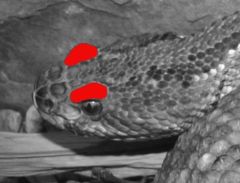
Supraocular scales
Encyclopedia

Squamata
Squamata, or the scaled reptiles, is the largest recent order of reptiles, including lizards and snakes. Members of the order are distinguished by their skins, which bear horny scales or shields. They also possess movable quadrate bones, making it possible to move the upper jaw relative to the...
, supraocular scales are (enlarged) scales on the crown immediately above the eye
Eye
Eyes are organs that detect light and convert it into electro-chemical impulses in neurons. The simplest photoreceptors in conscious vision connect light to movement...
. The size and shape of these scales are among the many characteristics used to differentiate species from each another.
In many species of boids
Boids
Boids is an artificial life program, developed by Craig Reynolds in 1986, which simulates the flocking behaviour of birds. His paper on this topic was published in 1987 in the proceedings of the ACM SIGGRAPH conference...
and viperids, the supraoculars are heavily fragmented. In others, such as the colubrids and elapids, they are enlarged.
See also

- Ocular scalesOcular scalesIn scaled reptiles, the ocular scales are those forming the margin of the eye. The name originates from the term oculus which is Latin for "eye" and, in the broadest sense, refers to a scale associated with the eye...
- Snake scalesSnake scalesSnakes, like other reptiles, have a skin covered in scales. Snakes are entirely covered with scales or scutes of various shapes and sizes. Scales protect the body of the snake, aid it in locomotion, allow moisture to be retained within, alter the surface characteristics such as roughness to aid in...
- Anatomical terms of locationAnatomical terms of locationStandard anatomical terms of location are designations employed in science that deal with the anatomy of animals to avoid ambiguities that might otherwise arise. They are not language-specific, and thus require no translation...

